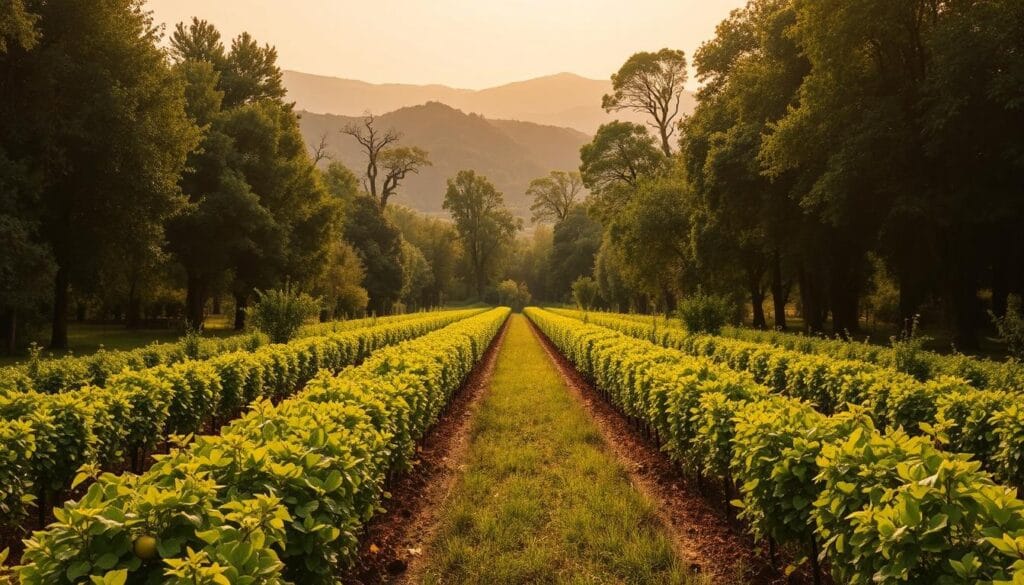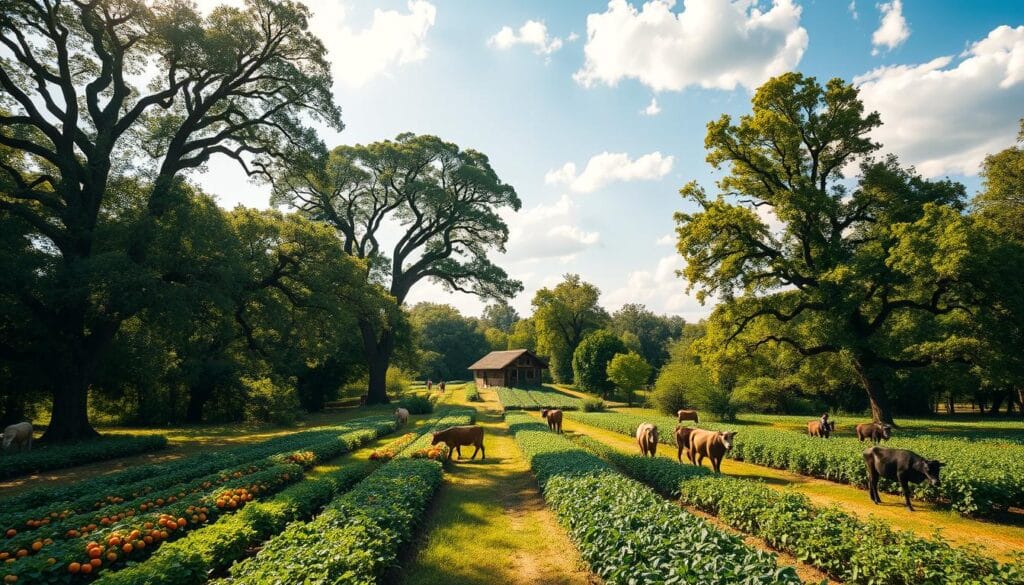Discover the power of Silvoarable systems in our Ultimate Guide. Learn how to integrate trees into your agricultural practices for a sustainable future.
Imagine walking through a farm where trees and crops grow side by side, their roots intertwined like partners in a dance. This isn’t just a vision it’s a reality for farmers embracing sustainable agroforestry. If you’ve ever wondered how to balance productivity with environmental care, this approach might hold the answers you’re seeking.
By integrating trees into crop fields, farmers create dual-purpose landscapes. Rows of timber or fruit-bearing trees stand tall while wide alleys between them host seasonal crops. This design doesn’t just look beautiful it works. Farmers maintain strong yields while gaining extra income from wood, nuts, or other tree products.
What makes these methods special? They’re built for modern farming. The spacing allows tractors and harvesters to move freely, proving sustainability doesn’t mean sacrificing efficiency. Over time, the trees improve soil quality and create habitats for wildlife, turning fields into thriving ecosystems.
Key Takeaways
- Combines annual crops with long-term tree cultivation for dual productivity
- Generates additional revenue streams through timber, fruits, or nuts
- Wide tree spacing enables full-scale farm machinery use
- Boosts soil health and supports biodiversity naturally
- Case studies like Parkhill Farm demonstrate real-world success
- Requires strategic planning for optimal tree-crop relationships
Understanding Silvoarable systems
Farmers are discovering how strategic tree planting boosts both harvests and ecosystems. This method blends annual crops with woody plants in shared spaces. Trees aren’t just background features—they’re active partners shaping healthier fields.
Definition and Core Concepts
Agroforestry combines crops with trees in planned layouts. Rows of timber or fruit trees stretch across fields, leaving wide alleys for seasonal planting. Farmers maintain 10-14 meters between tree lines—enough space for tractors to navigate freely.
North-South alignment maximizes sunlight for crops. This setup creates microclimates where plants grow better. Cooler soil stays moist longer, while tree roots recycle nutrients naturally.
The Role of Trees in Integrating Crop Production
Choosing the right tree species matters. Fast-growing varieties like walnut or apple provide shade without choking crops. Some farmers prune trees as pollards cutting branches high up to manage shade and harvest wood sustainably.
Deep roots pull nutrients from underground, feeding nearby plants. Over time, leaf litter enriches topsoil. Birds nest in branches, while earthworms thrive below a living network supporting your land’s health.
These partnerships yield more than food. Trees become extra income through nuts, lumber, or firewood. They turn ordinary fields into resilient ecosystems where every element works together.
Design and Establishment of Sustainable Agroforestry Solutions
Crafting a functional agroforestry layout starts with smart spatial planning. You need to balance crop productivity with long-term tree growth. The secret lies in arranging elements to work together, not compete.

Intercropping and Alley Cropping Techniques
Alley cropping turns tree rows into natural boundaries for annual crops. Wide 10-14 meter alleys let sunlight reach both plants and machinery. Farmers often use black plastic mulch between young trees to suppress weeds and lock in moisture.
Choosing compatible species prevents resource battles. Fast-growing timber varieties like poplar pair well with wheat or soybeans. Their deep roots avoid tangling with shallow crop systems. Some layouts use nurse trees—temporary plants that shelter saplings until they’re established.
| Planting Style | Tree Rows | Best For |
|---|---|---|
| Single Row | 12m spacing | Large machinery |
| Double Row | 8m between pairs | Wind protection |
| Triple Row | Nurse trees center | Harsh conditions |
Optimizing Tree Rows and Equipment Spacing
North-South alignment ensures equal light distribution. This setup lets morning and afternoon sun reach both sides of crops. Leave 3 meters between tree trunks and crop areas to prevent root competition.
Modern harvesters need 4-meter clearance. Plan rows wide enough for tractors to turn without damaging trunks. Protective tubes around saplings deter pests while allowing growth. Over time, leaf litter becomes natural fertilizer, reducing chemical needs.
| Spacing Type | Measurement | Purpose |
|---|---|---|
| Row Width | 10-14m | Machinery access |
| Crop Buffer | 3m | Root separation |
| Equipment Lane | 4m | Harvester turns |
Real-World Success Stories and Research Insights
Picture a farm where apple orchards double as windbreaks and native trees become livestock shelters. These aren’t theoretical concepts—they’re working models proving agroforestry’s potential. Let’s explore how innovative farmers and researchers are turning challenges into opportunities.

Case Study: Parkhill Farm’s Innovative Approach
At Scotland’s Parkhill Farm, 750 heritage apple trees stand alongside 10,000 native broadleaf trees. This design creates microclimates where sheep graze safely during storms. “Our fruit trees pay bills while the mixed species improve pasture quality,” explains the farm manager.
Strategic spacing—12 meters between tree rows—allows combine harvesters to collect barley without damage. Clover planted beneath apples naturally fertilizes soil, cutting synthetic nitrogen use by 40%.
Lessons Learned from UK Stakeholder Workshops
Farmers at Wakelyns Agroforestry reported initial crop yield drops near tree rows. Their solution? Shifting to min-till methods preserves soil structure while reducing competition. Protective tree tubes and adjusted planting dates helped saplings survive harsh winters.
“You need patience—the real benefits show in Year 5 when tree roots start feeding your crops.”
Enhancing Biodiversity and Soil Health
Diverse tree species create wildlife highways through fields. At Parkhill, bird populations tripled in three years, controlling pests naturally. Leaf litter from broadleaf trees boosted soil organic matter by 22%—equivalent to 15 truckloads of compost per acre.
These successes prove smart design choices pay off. Wider equipment lanes and nurse crops during establishment phases help farms transition smoothly to these layered growing systems.
Conclusion
Picture your fields thriving with trees and crops working in harmony. This approach turns ordinary farmland into layered ecosystems where every element supports productivity. By blending fruit or timber trees with annual plantings, you create dual-purpose spaces that boost yields while nurturing the land.
Strategic design matters most. Proper spacing between tree rows ensures machinery access while protecting saplings. Over years, deep roots enrich soil and leaf litter becomes natural fertilizer. Farms like Parkhill prove this works—their apples and clover partnerships cut chemical use by 40%.
Your choice of species shapes success. Fast-growing trees shelter crops without competition. Birds control pests naturally, and healthier soil means better harvests. These methods build resilience against harsh conditions while diversifying income.
Ready to transform your land? Start by exploring layouts that fit your goals. With careful planning, you’ll join farmers worldwide who grow food and forests simultaneously. The future of farming grows upward—will your fields rise to meet it?
Frequently Asked Questions
What are the main benefits of combining trees with crops?
Integrating trees like walnuts or apples with crops boosts soil health, reduces erosion, and diversifies income. This approach also enhances biodiversity by creating habitats for pollinators and wildlife while improving long-term land productivity.
How do you choose the right tree species for your land?
Consider soil type, climate, and crop compatibility. For example, apples thrive in well-drained soils, while hybrid poplars grow quickly in moist conditions. Pairing deep-rooted trees with shallow-rooted crops minimizes competition for nutrients.
Can machinery fit between tree rows without damaging them?
Yes. Spacing tree rows 12–15 meters apart allows standard farming equipment to operate. Protective measures like mulch mats or guards shield young saplings during field operations, ensuring both crops and trees thrive.
How long until agroforestry becomes profitable?
Annual crops provide immediate income, while timber or fruit yields take 5–10 years. Diversified revenue streams—like selling hazelnuts alongside grains—help balance short-term and long-term returns, as seen at Parkhill Farm’s model.
Does planting trees reduce crop yields?
Strategic designs prevent significant yield loss. For instance, alley cropping with nitrogen-fixing species like alder can improve soil fertility. Proper spacing and species selection ensure light and resource availability for both layers.
What support exists for transitioning to agroforestry?
Programs like the UK’s Environmental Land Management scheme offer grants. Research from institutions like Cranfield University provides tailored guidance on optimizing layouts for regional conditions and crop types.
How does this practice impact biodiversity?
Tree rows act as wildlife corridors, attracting birds and beneficial insects. Flowering species like cherry or crabapple support pollinators, while leaf litter enriches soil microbes, creating a resilient ecosystem.
Are there maintenance challenges with mixed systems?
Pruning and root management are key. Dwarf fruit varieties or coppiced timber species simplify upkeep. Regular soil testing ensures nutrient balance, preventing competition between crops and trees.


